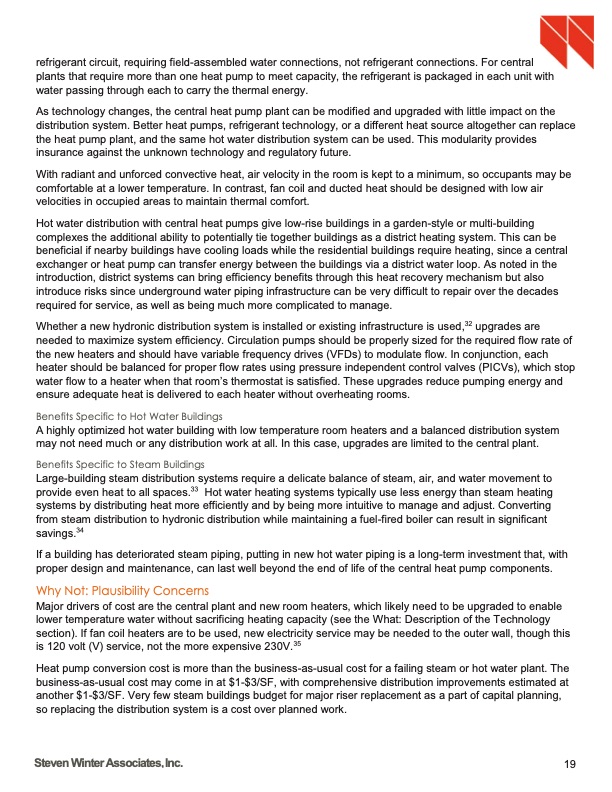
PDF Publication Title:
Text from PDF Page: 019
refrigerant circuit, requiring field-assembled water connections, not refrigerant connections. For central plants that require more than one heat pump to meet capacity, the refrigerant is packaged in each unit with water passing through each to carry the thermal energy. As technology changes, the central heat pump plant can be modified and upgraded with little impact on the distribution system. Better heat pumps, refrigerant technology, or a different heat source altogether can replace the heat pump plant, and the same hot water distribution system can be used. This modularity provides insurance against the unknown technology and regulatory future. With radiant and unforced convective heat, air velocity in the room is kept to a minimum, so occupants may be comfortable at a lower temperature. In contrast, fan coil and ducted heat should be designed with low air velocities in occupied areas to maintain thermal comfort. Hot water distribution with central heat pumps give low-rise buildings in a garden-style or multi-building complexes the additional ability to potentially tie together buildings as a district heating system. This can be beneficial if nearby buildings have cooling loads while the residential buildings require heating, since a central exchanger or heat pump can transfer energy between the buildings via a district water loop. As noted in the introduction, district systems can bring efficiency benefits through this heat recovery mechanism but also introduce risks since underground water piping infrastructure can be very difficult to repair over the decades required for service, as well as being much more complicated to manage. Whether a new hydronic distribution system is installed or existing infrastructure is used,32 upgrades are needed to maximize system efficiency. Circulation pumps should be properly sized for the required flow rate of the new heaters and should have variable frequency drives (VFDs) to modulate flow. In conjunction, each heater should be balanced for proper flow rates using pressure independent control valves (PICVs), which stop water flow to a heater when that room’s thermostat is satisfied. These upgrades reduce pumping energy and ensure adequate heat is delivered to each heater without overheating rooms. Benefits Specific to Hot Water Buildings A highly optimized hot water building with low temperature room heaters and a balanced distribution system may not need much or any distribution work at all. In this case, upgrades are limited to the central plant. Benefits Specific to Steam Buildings Large-building steam distribution systems require a delicate balance of steam, air, and water movement to provide even heat to all spaces.33 Hot water heating systems typically use less energy than steam heating systems by distributing heat more efficiently and by being more intuitive to manage and adjust. Converting from steam distribution to hydronic distribution while maintaining a fuel-fired boiler can result in significant savings.34 If a building has deteriorated steam piping, putting in new hot water piping is a long-term investment that, with proper design and maintenance, can last well beyond the end of life of the central heat pump components. Why Not: Plausibility Concerns Major drivers of cost are the central plant and new room heaters, which likely need to be upgraded to enable lower temperature water without sacrificing heating capacity (see the What: Description of the Technology section). If fan coil heaters are to be used, new electricity service may be needed to the outer wall, though this is 120 volt (V) service, not the more expensive 230V.35 Heat pump conversion cost is more than the business-as-usual cost for a failing steam or hot water plant. The business-as-usual cost may come in at $1-$3/SF, with comprehensive distribution improvements estimated at another $1-$3/SF. Very few steam buildings budget for major riser replacement as a part of capital planning, so replacing the distribution system is a cost over planned work. Steven Winter Associates,Inc. 19PDF Image | HEAT PUMP RETROFIT STRATEGIES FOR MULTIFAMILY BUILDINGS

PDF Search Title:
HEAT PUMP RETROFIT STRATEGIES FOR MULTIFAMILY BUILDINGSOriginal File Name Searched:
heat-pump-retrofit-strategies-report-05082019.pdfDIY PDF Search: Google It | Yahoo | Bing
CO2 Organic Rankine Cycle Experimenter Platform The supercritical CO2 phase change system is both a heat pump and organic rankine cycle which can be used for those purposes and as a supercritical extractor for advanced subcritical and supercritical extraction technology. Uses include producing nanoparticles, precious metal CO2 extraction, lithium battery recycling, and other applications... More Info
Heat Pumps CO2 ORC Heat Pump System Platform More Info
| CONTACT TEL: 608-238-6001 Email: greg@infinityturbine.com | RSS | AMP |